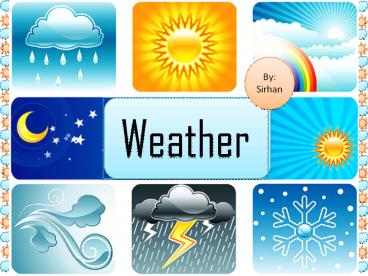Weather - PowerPoint PPT Presentation
Title:
Weather
Description:
This presentation will explain all about weather-Science – PowerPoint PPT presentation
Number of Views:700
Title: Weather
1
Weather
By Sirhan
2
What is Weather?
- Weather is the state of the atmosphere, to the
degree that it is hot or cold, wet or dry, calm
or stormy, clear or cloudy. - Weather generally refers to day-to-day
temperature and precipitation activity, whereas
climate is the term for the statistics of
atmospheric conditions over longer periods of
time.
3
Why Weather can be happen?
- Weather is driven by air pressure (temperature
and moisture) differences between one place and
another. These pressure and temperature
differences can occur due to the sun angle at any
particular spot, which varies by latitude from
the tropics.
4
Example Of Weather
5
Clouds
What are the different types of clouds and how
are they formed?
6
Types of Clouds
- Different types of clouds are formed at different
heights in the atmosphere. - The three main types of clouds are
- Cumulus clouds
- Stratus Clouds
- Cirrus Clouds
7
Cumulonimbus
- Cumulonimbus clouds extend from a height 2000 m
to 16 000 m in the atmosphere. When cumulus
clouds turn dark grey, they are called
cumulonimbus which can produce rain, hail or
lightning.
8
Cirrus
- Cirrus clouds are formed very high in the
atmosphere at 8000 m. These clouds are wispy and
light, and look like feathers in the sky.
9
Nimbostratus Clouds
- Nimbostratus clouds are formed below a height of
2400 m in the atmosphere. They bring long steady
rain and resemble grey blankets stretched out in
the sky.
10
Cumulus
- Cumulus clouds are formed at about a height of
2000 m in the atmosphere . Cumulus clouds are
white and fluffy like cotton balls.
11
Stratus
- Stratus clouds are formed below below a height
2000 m in the atmosphere. Stratus clouds are
flattened sheets of clouds that may stay over a
certain location for some time. They cause
overcast weather.
12
Fog
What is a fog and how is it formed?
13
Fog
- A fog is just like a low-lting cloud. It hovers
just above the ground because it is formed when
the ground is cold, such as in winter or at
night. The water vapour in the air condenses into
tiny droplets of water to form fog.
14
Dew
What is dew and how is it formed?
15
Dew
- Dew appears as drops of water on cold objects
usually in the early morning or late evening. Dew
is formed when water vapour in the air comes in
contact with a cold object of a temperature at or
below the dew point. The temperature at which
droplets can form is called the dew point. - The water vapour then condenses to form small
droplets on the copld surface.
16
Hail
What is hail and how is it formed?
17
Hail
- Hail is a form of precipitation that falls from
the sky as clumps of ice. Precipitation is
produced when water vapour from the sky condenses
and falls to the ground.
18
Formation of Hail
19
Wind
How is wind formed?
20
Wind
- The movement of air causes wind.
21
Formation of Wind
When Earth surface heated by the Sun, the air
above it is also heated up. The warm air expands
and rises into the upper atmosphere. In another
region, where the surface of Earth is cooler.
Cooler air from the region of higher pressure
rushes in to replace the warm air
22
Effects of Wind on Living Things and The
environment
- On Animals, Man, Plants, and Environment
23
Wind affects the activities of man, animals,
plants, and the environment. Man, other animals
and plants may use wind for their benefit but
sometimes , wind may have a negative effect on
the environment
24
Man
- Man relies on wind for some recreational
activities such as windsurfing and kite-flying.
We rely on wind to generate electricity in wind
power stations. However, strong wind may damage
properties and effect aviation.
25
Animals
- Some animals make use of the wind to smell their
prey. The smell of their predators in the wind
also helps warn some animals of any danger.
26
Plants
- Some plants need the wind to disperse their
seeds. However, strong winds may uproot trees.
27
Environment
- Wind causes rocks to erode. Strong winds that
carry heavy rain, such as tornadoes and
hurricanes, can cause floods.

